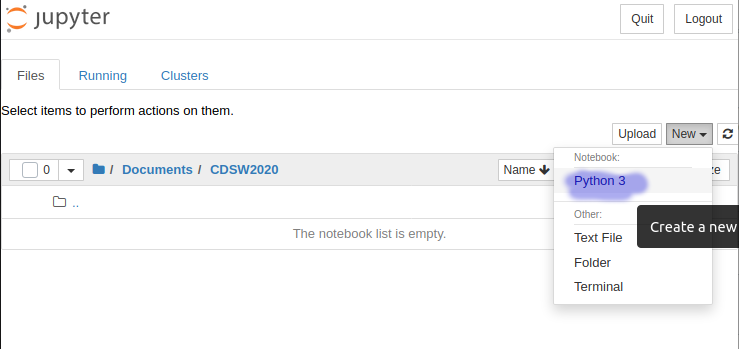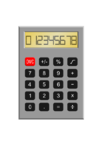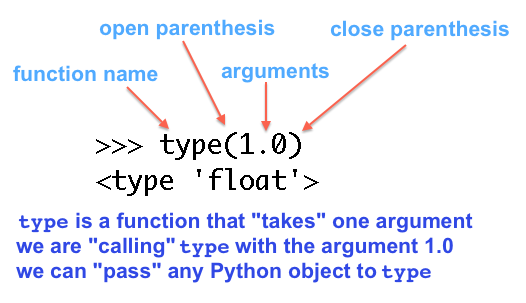Intro to Programming and Data Science (Fall 2023)/Day 1 Tutorial
Welcome to the first tutorial!
This tutorial introduces several core programming concepts that we'll build upon through the coming weeks. It will take 1-2 hours to complete. There's a break in the middle, and exercises at the middle and end to help review the material.
To get started, fire up a new Jupyter notebook. Name it as you like.

This is an interactive tutorial! As you go through this tutorial, any time you see something that looks like this:
a = "Hello"
you should type the expression in a new cell of your Jupyter notebook (found in the 'Insert' menu), then hold Shift and hit Return (or Enter) after every line and check the output, making sure it matches your expectations.
Unless otherwise noted, you should try not to copy and paste! You'll learn the concepts better if you type them out yourself.
The goal today is to introduce you to some of the basic syntax and concepts of Python. Nearly everything that we cover will be covered in more detail in the coming weeks, but this is a pretty gentle introduction to some key ideas.
Math
Math in Python looks a lot like math you type into a calculator. A Jupyter notebook makes a great calculator if you need to crunch some numbers and don't have a good calculator handy.
Addition
2 + 2
1.5 + 2.25
Subtraction
4 - 2
100 - .5
0 - 2
Multiplication
2 * 3
Division
First, lets try some basic fractions:
1 / 2
Sure enough, Python says that the answer is 0.5 which is the same as 1/2.
Let's try the same thing:
4 / 2
Hey now! That last result is a little strange. When you divide a number in Python, even if the answer doesn't need a decimal place (like 4/2 which equals 2), you get an answer with a decimal point!
What's going on here is that in Python, division produces an what's called a float which essentially means a number with a decimal point.
When the Python interpreter goes to do the division, it knows that (unlike multiplication for example) division can lead to numbers that aren't whole numbers (like 1/2) so it makes sure that the result will always include a decimal place just in case it's needed.
This shouldn't be important for this class but it might be worth knowing that older versions of Python (before version 3) would always round down and return integers instead of giving numbers with decimal places.
Types
There's a helpful function (more on what a function is in a second) called type that tells you what kind of thing -- what data type -- Python thinks something is. We can check for ourselves that Python considers '1' and '1.0' to be different data types:
type(1)
type(1.0)
So now we've seen two data types: integers and floats. Python tags your variables with a data type to make better guesses about what you want and to prevent errors. Another data type you'll run into is strings (a sequence of letters, numbers, and symbols, like the ones you're reading right now -- we'll look at strings a bit more in a moment).
What's a "function"? Here are the important ideas about functions:
- A function encapsulates (packages up) a useful bit of work and gives that work a name.
- You provide input to a function and it produces output. For example, the
typefunction takes data as an input, and produces what type of data the data is (e.g. an integer or a float) as output. - To use a function, write the name of the function, followed by an open parenthesis, then what the function needs as input (we call that input the arguments to the function), and then a close parenthesis.
- Programmers have a lot of slang around functions. They'll say that functions "take" arguments, or that they "give" or "pass" arguments to a function. "call" and "invoke" are both synonyms for using a function.
In the example above, "type" was the name of the function. type takes one argument; we first gave type an argument of 1 and then gave it an argument of 1.0.
Diagram of "calling" a function
Jupyter history
In your Jupyter notebook, any time you want to re-run a command, you can select that cell again and repeat the same Shift+Enter action to re-run the cell.
Variables
A lot of work gets done in Python using variables. Variables are a lot like the variables in math class, except that in Python variables can be of any data type, not just numbers.
type(4)
x = 4
x
type(x)
2 * x
Giving a name to something, so that you can refer to it by that name, is called assignment. Above, we assigned the name 'x' to 4, and after that we can use x wherever we want to use the number 4. You'll see that there wasn't any output here when you assigned 4 to x; that's fine! Not all Python operations have output, and in fact most of the time that's what you expect.
Variables can't have spaces or other special characters, and they need to start with a letter. Here are some valid variable names:
magic_number = 1500
amountOfFlour = .75
my_name = "Jessica"
Projects develop naming conventions: maybe multi-word variable names use underscores (like magic_number), or "camel case" (like amountOfFlour). The most
important thing is to be consistent within a project, because it makes the code more readable.
Output
Notice how if you type a 4 and hit enter, the Python interpreter spits a 4 back out:
4
But if you assign 4 to a variable, nothing is printed:
x = 4
You can think of it as that something needs to get the output. Without an assignment, the winner is the screen. With assignment, the output goes to the variable.
You can reassign variables if you want. What do you think will print if you type in:
x = 4
x
x = 5
x
Sometimes reassigning a variable is an accident and causes bugs in programs.
x = 3
y = 4
x * y
x * x
2 * x - 1 * y
Order of operations works pretty much like how you learned in school. If you're unsure of an ordering, you can add parentheses like on a calculator:
(2 * x) - (1 * y)
Note that the spacing doesn't matter:
x = 4
and
x=4
are both valid Python and mean the same thing.
(2 * x) - (1 * y)
and
(2*x)-(1*y)
are also both valid and mean the same thing. You should strive to be consistent with whatever spacing you like or a job requires, since it makes reading the code easier.
You aren't cheating and skipping typing these exercises out, are you? Good! :)
Strings
So far we've seen two data types: integers and floats. Another useful data type is a string, which is just what Python calls a bunch of characters (like numbers, letters, whitespace, and punctuation) put together. Strings are indicated by being surrounded by quotes:
"Hello"
"Python, I'm your #1 fan!"
Like with the math data types above, we can use the type function to check the type of strings:
type("Hello")
type(1)
type("1")
String Concatenation
You can smoosh strings together (called "concatenation") using the '+' sign:
"Hello" + "World"
name = "Jessica"
"Hello " + name
How about concatenating different data types?
"Hello" + 1
Hey now! The output from the previous example was really different and interesting; let's break down exactly what happened: (you'll see a slightly different "Traceback" statement, that difference doesn't matter.)
In[ ]: "Hello" + 1 Traceback (most recent call last): File "<stdin>", line 1, in <module> TypeError: cannot concatenate 'str' and 'int' objects
Python is giving us a traceback. A traceback is details on what was happening when Python encountered an Exception or Error -- something it doesn't know how to handle.
There are many kinds of Python errors, with descriptive names to help us humans understand what went wrong. In this case we are getting a TypeError: we tried to do some operation on a data type that isn't supported for that data type.
Python gives us a helpful error message as part of the TypeError:
"cannot concatenate 'str' and 'int' objects"
We saw above that we can concatenate strings:
"Hello" + "World"
works just fine.
However,
"Hello" + 1
produces a TypeError. We are telling Python to concatenate a string and an integer, and that's not something Python understands how to do.
We can convert an integer into a string ourselves, using the str function:
"Hello" + str(1)
Like the type function from before, the str function takes 1 argument. In the above example it took the integer 1. str takes a Python object as input and produces a string version of that input as output.
String length
There's another useful function that works on strings called len. len returns the length of a string as an integer:
len("Hello")
len("")
fish = "humuhumunukunukuapua'a"
name_length = len(fish)
fish + " is a Hawaiian fish whose name is " + str(name_length) + " characters long."
Quotes
We've been using double quotes around our strings, but you can use either double or single quotes:
'Hello'
"Hello"
Like with spacing above, use whichever quotes make the most sense for you, but be consistent.
You do have to be careful about using quotes inside of strings:
'I'm a happy camper'
This gives us another traceback, for a new kind of error, a SyntaxError. When Python looks at that expression, it sees the string 'I' and then
m a happy camper'
which it doesn't understand -- it's not 'valid' Python. Those letters aren't variables (we haven't assigned them to anything), and that trailing quote isn't balanced. So it raises a SyntaxError.
We can use double quotes to avoid this problem:
"I'm a happy camper"
One fun thing about strings in Python is that you can multiply them:
"A" * 40
"ABC" * 12
h = "Happy"
b = "Birthday"
(h + b) * 10
Part 1 Practice
Read the following expressions, but don't execute them. Guess what the output will be. After you've made a guess, copy and paste the expressions into your Jupyter notebook and check your guess.
1.
total = 1.5 - 1/2
total
print(type(total))
2.
a = "quick"
b = "brown"
c = "fox jumps over the lazy dog"
print("The " + a * 3 + " " + b * 3 + " " + c)
End of Part 1
Congratulations! You've learned about and practiced math, strings, variables, data types, exceptions, tracebacks, and executing Python from the Python prompt.
Take a break, stretch, meet some neighbors, and ask the staff if you have any questions about this material.
Making choices
We can use these expressions that evaluate to booleans to make decisions and conditionally execute code.
if statements
The simplest way to make a choice in Python is with the if keyword. Here's an example (don't try to type this one, just look at it for now):
if 6 > 5:
print("Six is greater than five!")
That is our first multi-line piece of code, and the way to type it into a Jupyter notebook is a little different. Let's break down how to do this (type this out step by step):
First, type the if 6 > 5:, then hit enter. Not Shift + Enter, because this time we want to write more than one line before we ask Jupyter to run it!
Once you've hit enter, you'll see that your carat is indented already for you; Jupyter understands that you're now inside the if code block, and adjusts your indentation position for you. In Python, all lines of a block are at the same indentation level, and the block ends when you reduce your indentation again.
Write print("Six is greater than five!"), then hit enter, and now hit Shift+Enter to run this if statement!
- First, type the
if 6 > 5:
part, and press Enter. . - You'll notice that your text caret (|) will be indented by four spaces. This is important, and it tells python that you're telling it what to do with your if statement.
- Type
print("Six is greater than five!") - Press shift-enter to tell Jupyter to run that block of code.
All together, it will look like this:
if 6 > 5:
print("Six is greater than five!")
Six is greater than five!
What is going on here? When Python encounters the if keyword, it evaluates the expression following the keyword and before the colon. If that expression is True, Python executes the code in the indented code block under the if line. If that expression is False, Python skips over the code block.
In this case, because 6 really is greater than 5, Python executes the code block under the if statement, and we see "Six is greater than five!" printed to the screen. Guess what will happen with these other expressions, then type them out and see if your guess was correct:
if 0 > 2:
print("Zero is greater than two!")
if "banana" in "bananarama":
print("I miss the 80s.")
more choices: if and else
if lets you execute some code only if a condition is True. What if you want to execute different code if a condition is False?
Use the else keyword, together with if, to execute different code when the if condition isn't True. Try this:
sister_age = 15
brother_age = 12
if sister_age > brother_age:
print("sister is older")
else:
print("brother is older")
Like with if, the code block under the else condition must be indented so Python knows that it is a part of the else block.
compound conditionals: and and or
You can check multiple expressions together using the and and or keywords. If two expressions are joined by an and, they both have to be True for the overall expression to be True. If two expressions are joined by an or, as long as at least one is True, the overall expression is True.
Try typing these out and see what you get:
1 > 0 and 1 < 2
1 < 2 and "x" in "abc"
"a" in "hello" or "e" in "hello"
1 <= 0 or "a" not in "abc"
Guess what will happen when you enter these next two examples, and then type them out and see if you are correct. If you have trouble with the indenting, call over a staff member and practice together. It is important to be comfortable with indenting for tomorrow.
temperature = 32
if temperature > 60 and temperature < 75:
print("It's nice and cozy in here!")
else:
print("Too extreme for me.")
hour = 11
if hour < 7 or hour > 23:
print("Go away!")
print("I'm sleeping!")
else:
print("Welcome to the cheese shop!")
print("Can I interest you in some choice gouda?")
You can have as many lines of code as you want in if and else blocks; just make sure to indent them so Python knows they are a part of the block.
even more choices: elif
If you need to execute code conditional based on more than two cases, you can use the elif keyword to check more cases. You can have as many elif cases as you want; Python will go down the code checking each elif until it finds a True condition or reaches the default else block.
sister_age = 15
brother_age = 12
if sister_age > brother_age:
print("sister is older")
elif sister_age == brother_age:
print("sister and brother are the same age")
else:
print("brother is older")
You don't have to have an else block, if you don't need it. That just means there isn't default code to execute when none of the if or elif conditions are True:
color = "orange"
if color == "green" or color == "red":
print("Christmas color!")
elif color == "black" or color == "orange":
print("Halloween color!")
elif color == "pink":
print("Valentine's Day color!")
If color had been "purple", that code wouldn't have printed anything.
Remember that '=' is for assignment and '==' is for comparison.
In summary: the structure of if/elif/else
Here's a diagram of if/elif/else:
Do you understand the difference between elif and else? When do you indent? When do you use a colon? If you're not sure, talk about it with a neighbor or staff member.
Booleans
Please return to the interactive Python interpreter for the rest of the tutorial. And remember: type out the examples. You'll thank yourself tomorrow. :)
So far, the code we've written has been unconditional: no choice is getting made, and the code is always run. Python has another data type called a boolean that is helpful for writing code that makes decisions. There are two booleans: True and False.
True
type(True)
False
type(False)
You can test if Python objects are equal or unequal. The result is a boolean:
0 == 0
0 == 1
Use == to test for equality. Recall that = is used for assignment.
This is an important idea and can be a source of bugs until you get used to it: = is assignment, == is comparison.
Use != to test for inequality:
"a" != "a"
"a" != "A"
<, <=, >, and >= have the same meaning as in math class. The result of these tests is a boolean:
1 > 0
2 >= 3
-1 < 0
.5 <= 1
You can check for containment with the in keyword, which also results in a boolean:
"H" in "Hello"
"X" in "Hello"
Or check for a lack of containment with not in:
"a" not in "abcde"
"Perl" not in "Python Workshop"
End of Part 2
Congratulations! You've learned about and practiced executing Python scripts, booleans, conditionals, and making choices with if, elif, and else. This is a huge, huge accomplishment!
Common Issues
I was expecting python to print lots of lines of text when I ran this cell, but it only prints one line!
Jupyter only outputs the last line of a code chunk unless you explicitly wrap the code in print() statements. If you split your code into multiple chunks or print() the line, it should look like you expect.
There are weird numbers next to my code and I didn't type them!
Those are line numbers. You can turn them off in the View:Toggle Line Numbers option at the top of the notebook.













